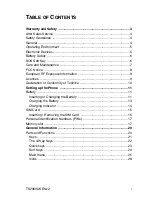
PG-1810 Service Manual
PANTECH R&D CONFIDENTIAL
3
SECTION 1
. I
NTRODUCTION
1.1 An Introduction of GSM Digital Cellular Mobile Communication System
GSM (Global System for Mobile communication) concluded that digital technology working in
the Time Division Multiple Access (TDMA) mode would provide the optimum solution for the
future system. Specifically , a TDMA system has the following advantage
►
Offers a possibility of channel splitting and advanced speech coding, resulting in improved
spectrum efficiency.
►
Allows considerable improvements to be made with regards to the protection of information.
The GSM system is basically designed as a combination of three major subsystems;
The network subsystem, the radio subsystem, and the operation support system.
The functional architecture of a GSM system can be divided into the Mobile Station (MS), the Base
Station (BS), and the Network Subsystem (NS). The MS is carried by the subscriber, the BS
subsystem controls the radio link with the MS and the NS performs the switching of calls between
the mobile and other fixed or mobile network users as well as mobility management. The MS and
the BS subsystem communicate across the Um interface also known as radio link
The specifications relating to MS are as follows:
TS 100 607-1 : Digital cellular telecommunication system()Mobile Station (MS) con
Formance specification Part1: Conformance specification
1.2 Frequency Allocation and Its Use
Transmit frequency band : 824 MHz ~ 849 MHz(For GSM850), 1850 MHz ~ 1910 MHz (For
PCS1900), 1710 ~ 1785 MHz (For DCS)
Receive frequency band: 869 MHz ~ 894 MHz(For GSM850) , 1930 MHz ~ 1990 MHz (For
PCS1900), 1805 MHz ~ 1880 MHz(For DCS)
Channel spacing : 200 KHz
ARFCN(Absolute Radio Frequency Channel Number) : 128~251 (For GSM850), 512~810 (For
PCS1900), 512~885 (For DCS).
Separation between Transmit and Receive channels [MHz] : GSM850 : 45 MHz, DCS : 95 MHz,
PCS ;80 MHz
For GSM850 Band Fl(n)=824.2+0.2*(n-128) 128
≤
n
≤
251 Fu(n)=Fl(n)+45
824
MHz
~849
MHz
: Mobile Transmit,Base receive
869
MHz
~894
MHz
: Base Transmit, Mobile receive
For PCS Band Fl(n)=1850.2+0.2*(n-512) 512
≤
n
≤
810 Fu(n)=Fl(n)+80
1850
MHz
~1910
MHz
: Mobile Transmit,Base receive
1930
MHz
~1990
MHz
: Base Transmit, Mobile receive
** Fl(n)= frequency value of the carrier , Fu(n)= corresponding frequency value in upper band
For DCS Band Fl(n)=1710.2+0.2*(n-512) 512
≤
n
≤
885 Fu(n)=Fl(n)+95
1710 MHz ~1785 MHz : Mobile Transmit,Base receive
1805 MHz ~1880 MHz : Base Transmit, Mobile receive
Summary of Contents for PG-1810
Page 9: ...PG 1810 Service Manual PANTECH R D CONFIDENTIAL 8 3 4 BLUETOOTH MODULE...
Page 43: ...PG 1810 Service Manual PANTECH R D CONFIDENTIAL 42 CP137 CP138 CP136...
Page 45: ...PG 1810 Service Manual PANTECH R D CONFIDENTIAL 44 CP140 CP139 CP141...
Page 47: ...PG 1810 Service Manual PANTECH R D CONFIDENTIAL 46 CP145...
Page 50: ...PG 1810 Service Manual PANTECH R D CONFIDENTIAL 49 CP147 CP148 CP149...
Page 51: ...PG 1810 Service Manual PANTECH R D CONFIDENTIAL 50 CP150...





































